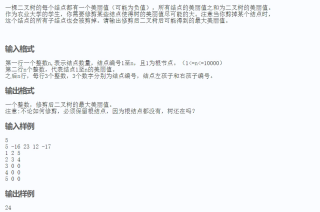该回答引用ChatGPT
以下是一种使用动态规划(DP)的解决方案。
定义dp[i][0]表示以结点i为根的子树中,不剪掉结点i时的最大美丽值,dp[i][1]表示以结点i为根的子树中,剪掉结点i时的最大美丽值。
对于dp[i][0],可以使用以下递归公式:
dp[i][0] = beauty[i] + max(dp[lson][0], 0) + max(dp[rson][0], 0)
其中beauty[i]表示结点i的美丽值,lson和rson分别表示结点i的左右儿子。如果子树的美丽值小于0,可以不选,所以使用max(dp[lson][0], 0)和max(dp[rson][0], 0)。
对于dp[i][1],可以使用以下递归公式:
dp[i][1] = max(dp[lson][0], 0) + max(dp[rson][0], 0)
因为剪掉结点i时,其左右子树的根节点都会被剪掉,所以子树的美丽值只能由dp[lson][0]和dp[rson][0]中的最大值组成。
最终答案为max(dp[1][0], dp[1][1]),其中1表示整棵树的根节点。
以下是C++代码实现:
#include <iostream>
#include <algorithm>
using namespace std;
const int N = 10010;
int n;
int beauty[N];
int lson[N], rson[N];
int dp[N][2];
void dfs(int u) {
if (lson[u]) {
dfs(lson[u]);
dp[u][0] += max(dp[lson[u]][0], 0);
dp[u][1] += max(dp[lson[u]][0], 0);
}
if (rson[u]) {
dfs(rson[u]);
dp[u][0] += max(dp[rson[u]][0], 0);
dp[u][1] += max(dp[rson[u]][0], 0);
}
}
int main() {
cin >> n;
for (int i = 1; i <= n; i++) cin >> beauty[i];
for (int i = 1; i <= n; i++) {
int u;
cin >> u >> lson[u] >> rson[u];
}
dfs(1);
int ans = max(dp[1][0], dp[1][1]);
cout << ans << endl;
return 0;
}

